Using the slope-intercept form:
y = m*x + b |
Using the slope-intercept form:
y = a + b*x |
| Situation 1: Find the equation of a line if we are
told that the slope is ¾ and the
y-intercept is at the point (0,5). |
We have the y-intercept form as y = m*x + b, where
m is the slope and b is the second coordinate of the y-intercept.
But we told that m is ¾ and the y-intercept is the point
(0,5), which means that b is 5.
Therefore, our equation is
y = ¾*x + 5

|
We have the y-intercept form as y = a + b*x, where
a is the second coordinate of the y-intercept and
b is the slope.
But we told that b is ¾ and the y-intercept is the point
(0,5), which means that a is 5.
Therefore, our equation is
y = 5 + ¾*x
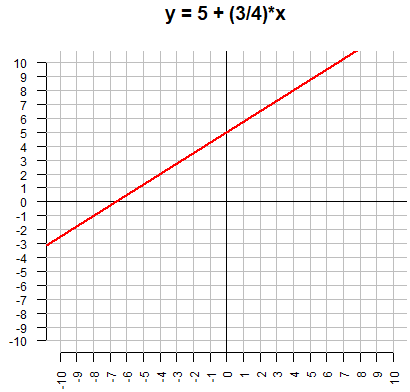
|
| Situation 2: Find the equation of a line if we are told that the slope is 2.5 and the
the line contains the point (4,7). |
We have the y-intercept form as y = m*x + b, where
m is the slope and b is the second coordinate of the y-intercept.
But we told that m is 2.5.
However, we have no idea about the value of the y-intercept.
We can at least start writing the equation of the line as
y = 2.5*x + b
But we know that the point (4,7) has to make that equation work, so we know that
7 = 2.5*4 + b
We can simplify this to
7 = 10 + b
and then solve that for b,
− 3 = b
But that means that we now know the value of b so our final equation becomes
y = 2.5*x + − 3
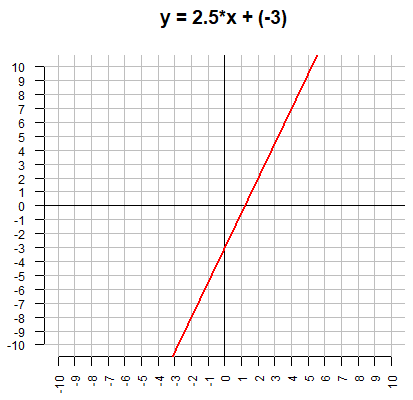
|
We have the y-intercept form as y = a + b*x, where
a is the second coordinate of the y-intercept and
b is the slope.
But we told that b is 2.5.
However, we have no idea about the value of the y-intercept.
We can at least start writing the equation of the line as
y = a + 2.5*x
But we know that the point (4,7) has to make that equation work, so we know that
7 = a + 2.5*4
We can simplify this to
7 = a + 10
and then solve that for a,
− 3 = a
But that means that we now know the value of a so our final equation becomes
y = − 3 + 2.5*x
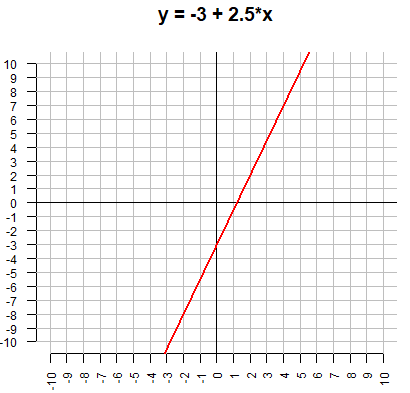
|
| Situation 3: Find the equation of a line if we are told that
y-intercept is (0,2)
the line contains the point (6,-7). |
We have the y-intercept form as y = m*x + b, where
m is the slope and b is the second coordinate of the y-intercept.
But we told that b is 2.
However, we have no idea about the value of the slope.
We can at least start writing the equation of the line as
y = m*x + 2
But we know that the point (6,-7) has to make that equation work, so we know that
-7 = m*6 + 2
We can simplify this to
-9 = m*6
and then solve that for m,
− 9/6 = m
or
− 3/2 = m
But that means that we now know the value of m so our final equation becomes
y = (− 3/2)*x + 2

|
We have the y-intercept form as y = a + b*x, where
a is the second coordinate of the y-intercept and
b is the slope.
But we told that a is 2.
However, we have no idea about the value of the slope.
We can at least start writing the equation of the line as
y = 2 + b*x
But we know that the point (6,-7) has to make that equation work, so we know that
-7 = 2 + b*6
We can simplify this to
-9 = b*6
and then solve that for b,
− 9/6 = b
or
− 3/2 = b
But that means that we now know the value of b so our final equation becomes
y = 2 + (-3/2)*x
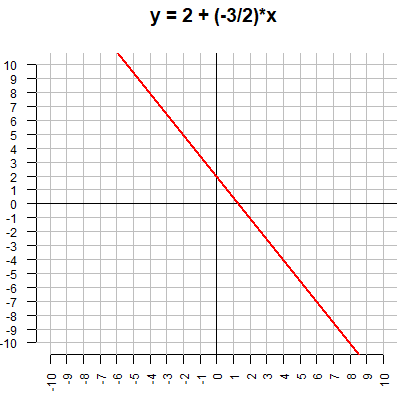
|
| Situation 4: Find the equation of a line if we are told that
the line contains the point (-4,-2) and the point (8,-5). |
We have the y-intercept form as y = m*x + b, where
m is the slope and b is the second coordinate of the y-intercept.
However, we have no idea about the value of the either the slope or the y-intercept.
We do know two points on the line. If we say that point 1 is
(x1,y1) = (8,-5) and
that point 2 is
(x2,y2) = (-4,-2) then
we can compute the slope of the line containing those two points as
m =
y2 − y1
/
x2 − x1
=
-5 − (-2)
/
8 − (-4)
=
-3
/
12
=
-1
/
4
. Now we know that m=(-1/4).
We can at least start writing the equation of the line as
y = (-1/4)*x + b
But we know that the point (8,-5) has to make that equation work, so we know that
-5 = (-1/4)*8 + b
We can simplify this to
-5 = -2 + b
and then solve that for b,
− 3 = b
But that means that we now know the value of b so our final equation becomes
y = (− 1/4)*x + − 3
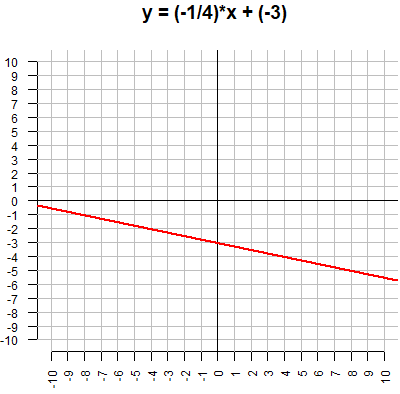
|
We have the y-intercept form as y = a + b*x, where
a is the second coordinate of the y-intercept and
b is the slope.
However, we have no idea about the value of the either the slope or the y-intercept.
We do know two points on the line. If we say that point 1 is
(x1,y1) = (8,-5) and
that point 2 is
(x2,y2) = (-4,-2) then
we can compute the slope of the line containing those two points as
b =
y2 − y1
/
x2 − x1
=
-5 − (-2)
/
8 − (-4)
=
-3
/
12
=
-1
/
4
. Now we know that b=(-1/4).
y = a + (-1/4)*x
But we know that the point (8,-5) has to make that equation work, so we know that
-5 = a + (-1/4)*8
We can simplify this to
-5 = a + (-2)
and then solve that for a,
− 3 = a
But that means that we now know the value of a so our final equation becomes
y = -3 + (-1/4)*x

|







